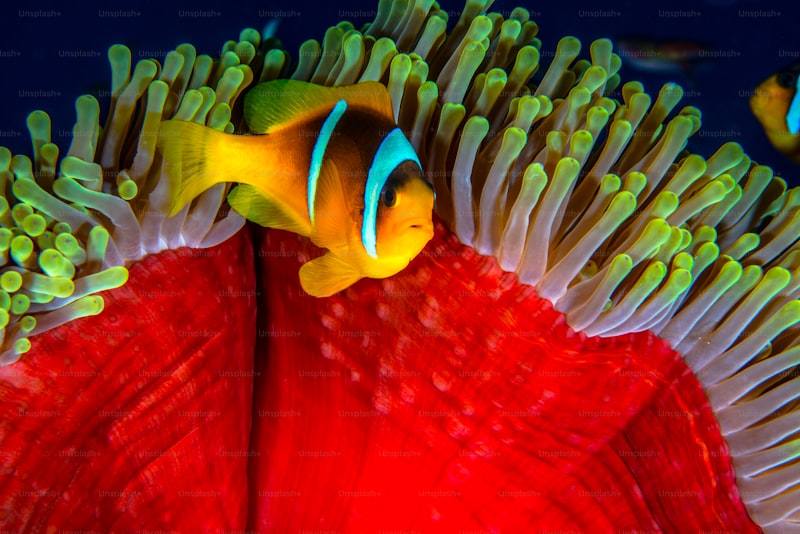Have you ever gazed into the mesmerizing world of coral gardens beneath the ocean’s surface? These vibrant ecosystems, teeming with life and color, are a true marvel of nature. Imagine yourself diving into the crystal-clear waters of a tropical paradise, surrounded by coral reefs that resemble a bustling underwater city.
Coral gardens are not just beautiful; they are vital hubs of biodiversity. Picture a kaleidoscope of coral species, each one unique in shape and color, creating a mosaic of life beneath the waves. These organisms, often mistaken for rocks or plants, are actually colonies of tiny animals called polyps, working together to build their limestone skeletons over centuries.
The colors of coral gardens are a sight to behold. From the electric blues of the Acropora to the fiery oranges of the Montipora, these hues are not merely for show but serve a crucial purpose in the survival of coral reefs. They attract symbiotic algae called zooxanthellae, which provide corals with essential nutrients through photosynthesis, keeping the entire ecosystem thriving.
But coral gardens face challenges today. Climate change, pollution, and overfishing threaten their delicate balance. Rising sea temperatures lead to coral bleaching, where corals expel their colorful algae and turn ghostly white. Without these algae, corals weaken and are more susceptible to disease and death, leaving behind barren skeletons.
Conservation efforts are crucial to preserving coral gardens for future generations. Marine protected areas, sustainable tourism practices, and reducing carbon emissions are steps in the right direction. Each of us can make a difference by learning about coral reefs, supporting conservation initiatives, and making sustainable choices in our daily lives.
Next time you see a picture of coral gardens or have the opportunity to snorkel among them, take a moment to appreciate their beauty and complexity. These underwater wonders remind us of the incredible diversity of life on Earth and the importance of protecting our oceans.
Underwater Wonders: Exploring the Enchanting Coral Gardens
Have you ever imagined stepping into a world where colors dance beneath the waves, painting a mesmerizing picture of life? Welcome to the enchanting realm of coral gardens, where nature’s artistry thrives beneath the sea. These underwater wonders, with their vibrant hues and intricate formations, captivate adventurers and marine enthusiasts alike.
Imagine snorkeling through crystal-clear waters, surrounded by a kaleidoscope of corals in every shade imaginable – from fiery reds to soothing blues. Each coral colony is a bustling city of tiny polyps, diligently building their calcium carbonate homes over centuries. These structures not only provide shelter to a myriad of marine life but also serve as crucial habitats for countless species.
The diversity found within coral gardens is truly astounding. Delicate sea fans sway gently in the currents, while schools of colorful fish dart in and out of the labyrinthine reefs. It’s a bustling metropolis where every inhabitant plays a vital role in maintaining the ecosystem’s delicate balance.
Beyond their aesthetic appeal, coral gardens are invaluable ecosystems that support global biodiversity. They act as nurseries for juvenile fish, protect coastlines from erosion, and contribute to carbon and nitrogen cycling in the ocean. Sadly, these underwater paradises are increasingly threatened by climate change, pollution, and overfishing, making conservation efforts more crucial than ever.
Exploring coral gardens isn’t just about witnessing natural beauty – it’s about understanding our interconnectedness with the marine environment. It’s about marveling at the resilience of life beneath the waves and recognizing our responsibility to protect it for future generations.
So, whether you’re a seasoned diver or an armchair explorer, dive into the depths of coral gardens and discover a world where nature’s creativity knows no bounds. Let the colors, shapes, and stories of these underwater wonders inspire you to appreciate and safeguard the fragile beauty of our oceans.
Colorful Coral Reefs: Nature’s Living Masterpieces Unveiled
Have you ever wondered about the vibrant underwater worlds hidden beneath the ocean’s surface? Coral reefs, often called the “rainforests of the sea,” are among the most breathtaking sights nature has to offer. These intricate ecosystems teem with life, boasting a kaleidoscope of colors that rival any artist’s palette.
Imagine stepping into an underwater city where every corner is adorned with vibrant hues of red, orange, yellow, and blue. Coral reefs are built by tiny marine animals called coral polyps, which secrete calcium carbonate to form hard skeletons. These structures provide a foundation for the reef and create a haven for countless marine species.
But it’s not just their beauty that makes coral reefs remarkable. They play a crucial role in supporting marine biodiversity and protecting coastal areas from erosion. These underwater gardens are home to a staggering variety of fish, crustaceans, mollusks, and other sea creatures, all interconnected in a delicate balance of life.
Sadly, coral reefs around the world are facing unprecedented threats. Climate change, pollution, overfishing, and destructive fishing practices are causing irreversible damage to these fragile ecosystems. Rising ocean temperatures lead to coral bleaching, where corals expel the algae living in their tissues, turning them white and vulnerable to disease.
Conservation efforts are underway to preserve and restore coral reefs. Marine protected areas, sustainable fishing practices, and reducing carbon emissions are essential steps in safeguarding these natural wonders for future generations to marvel at. Each of us has a role to play in protecting coral reefs, whether through raising awareness, supporting conservation organizations, or making environmentally conscious choices in our daily lives.
Next time you gaze upon a photograph of a vibrant coral reef, remember that it represents more than just a colorful display. It symbolizes the resilience of nature and the interconnectedness of life below the waves. Let’s work together to ensure that these living masterpieces continue to thrive and inspire awe for generations to come.
Diving into Diversity: The Fascinating Ecosystems of Coral Gardens
Coral gardens are not just underwater landscapes; they are vibrant ecosystems teeming with life and color. Imagine diving into a world where every corner reveals a new species, each intricately woven into the fabric of the reef. These gardens of the sea are like bustling cities, bustling with activity and diversity.
At first glance, coral reefs may appear as simple structures, but they are complex communities built over centuries by tiny coral polyps. These creatures, resembling delicate flowers, work tirelessly to construct calcium carbonate skeletons that form the backbone of the reef. Each species of coral brings its unique shape, size, and color palette, contributing to the kaleidoscope of hues that adorn the underwater landscape.

Diversity thrives within coral gardens, showcasing an astonishing array of marine life. From graceful sea turtles gliding through the water to schools of vibrant fish darting among the branches, every creature plays a crucial role in this delicate ecosystem. The corals themselves provide shelter and breeding grounds for countless species, fostering a web of life that spans from the tiniest plankton to the apex predators of the sea.
Yet, these ecosystems face numerous threats, from rising sea temperatures to pollution and overfishing. Coral bleaching events, triggered by environmental stressors, have devastated reefs worldwide, highlighting the fragility of these biodiverse havens.
Exploring coral gardens isn’t just an adventure; it’s an opportunity to witness nature’s creativity and resilience in action. It prompts us to marvel at the intricate relationships between organisms and the delicate balance that sustains life beneath the waves.
So, next time you dip beneath the surface and immerse yourself in the world of coral gardens, take a moment to appreciate the diversity and wonder that abound in these underwater realms. Each dive reveals new wonders and underscores the importance of preserving these ecosystems for future generations to explore and cherish.
Guardians of the Seas: Preserving the Fragile Beauty of Coral Gardens
Imagine diving into a world where colors dance around you like a living kaleidoscope. Coral gardens are not just visually stunning; they are also home to countless marine species, providing shelter, food, and breeding grounds. From tiny fish seeking refuge to majestic sea turtles gliding gracefully through the water, these reefs support a delicate web of life.
But despite their beauty, coral gardens face significant threats. Climate change, pollution, overfishing, and destructive fishing practices pose grave risks to their survival. Rising sea temperatures lead to coral bleaching, where corals expel the algae living in their tissues, causing them to turn white and making them more susceptible to disease.
Efforts to preserve these fragile ecosystems are more critical than ever. Conservation initiatives aim to mitigate human impacts, restore damaged reefs, and raise awareness about the importance of coral reef ecosystems. Through sustainable tourism practices and marine protected areas, communities and governments work together to safeguard these invaluable natural resources.
Preserving coral gardens isn’t just about protecting biodiversity; it’s about securing our planet’s future. Coral reefs contribute to coastal protection, shoreline stabilization, and sustainable fisheries, benefiting millions of people worldwide. As stewards of the seas, it’s our responsibility to ensure these guardians continue to thrive for generations to come.
In the vastness of the ocean, coral gardens stand as testament to nature’s resilience and beauty. Their survival depends on our collective efforts to reduce carbon emissions, curb pollution, and promote sustainable practices. Together, we can preserve the fragile beauty of coral gardens and safeguard the rich tapestry of life they support.
Secrets of Coral Gardens: Unraveling the Mysteries Beneath the Waves
Coral gardens are not just beautiful; they are essential to the health of our oceans. Acting as underwater cities, corals provide shelter and food for countless species of fish, crustaceans, and other marine organisms. Their intricate structures offer protection from predators and strong currents, fostering biodiversity in the midst of the sea.

But how do these coral gardens thrive in such harsh underwater environments? The answer lies in a delicate dance between coral polyps and algae. Corals themselves are tiny animals called polyps, which build calcium carbonate skeletons that form the backbone of coral reefs. These skeletons provide a sturdy framework for the colonies to grow and expand over time.
Yet, corals cannot survive on their own. They rely on a symbiotic relationship with photosynthetic algae called zooxanthellae, which live within their tissues. These algae harness sunlight to produce sugars through photosynthesis, providing corals with essential nutrients and oxygen in return. This mutual dependence allows coral gardens to flourish in nutrient-poor tropical waters, where other forms of life struggle to survive.
The mysteries of coral gardens extend beyond their biological marvels. They also serve as invaluable indicators of environmental health. Sensitivity to changes in water temperature, pollution, and acidity makes corals vulnerable to stress, leading to bleaching events that devastate entire reef ecosystems. Understanding these vulnerabilities is crucial for conservation efforts aimed at preserving these underwater wonders for future generations.
Beyond the Blue: Discovering the Vibrant Life in Coral Gardens
Have you ever wondered what lies beneath the serene surface of the ocean? Beyond the shimmering blue waters, a world of vibrant colors and bustling life thrives in coral gardens. These underwater ecosystems are not just a sight to behold but are also crucial to our planet’s biodiversity.
Imagine diving into the crystal-clear waters, surrounded by coral formations that resemble a bustling metropolis of marine life. Each coral colony, like a tiny apartment complex, hosts a diverse community of fish, crustaceans, and other sea creatures. It’s a bustling neighborhood where every resident plays a vital role in maintaining the delicate balance of the ecosystem.
Coral reefs are often referred to as the “rainforests of the sea” due to their incredible biodiversity. They provide shelter and food for countless species, from colorful tropical fish to majestic sea turtles. These reefs are not only beautiful but also serve as natural barriers, protecting coastlines from erosion and storms.
But coral reefs are facing unprecedented threats today. Climate change, pollution, overfishing, and ocean acidification are taking a toll on these fragile ecosystems. As temperatures rise and oceans become more acidic, corals struggle to survive, leading to coral bleaching—a phenomenon where corals expel the algae living in their tissues, causing them to turn white and eventually die.
Conservation efforts are crucial to preserving these underwater wonders. Governments, scientists, and environmental organizations are working together to establish marine protected areas, promote sustainable fishing practices, and reduce pollution. Individuals can also make a difference by supporting eco-friendly tourism and choosing sustainable seafood options.
Exploring coral gardens is like entering a magical world where every corner reveals a new wonder. It’s a reminder of the incredible diversity and resilience of life on Earth. So, next time you gaze out at the ocean, remember that beneath the surface lies a world of vibrant colors and extraordinary beauty waiting to be discovered and protected for generations to come.
Symbiotic Symphony: How Coral Gardens Support Marine Biodiversity
Coral gardens, often referred to as coral reefs, are not just breathtaking natural formations; they are vital ecosystems teeming with life. Imagine them as bustling cities underwater, where every structure, every inhabitant, contributes to a delicate balance that supports an incredible array of marine species.
At the heart of this symbiotic symphony are the corals themselves. These tiny, yet resilient animals form colonies that create vast underwater structures. Through a remarkable process called symbiosis, corals host microscopic algae called zooxanthellae within their tissues. This partnership is mutually beneficial: the algae provide corals with essential nutrients and oxygen through photosynthesis, while the corals offer shelter and compounds necessary for photosynthesis. This collaboration not only sustains the corals but also forms the foundation of the entire reef ecosystem.
But corals aren’t the only players in this symphony. The reef structure they create provides shelter, breeding grounds, and hunting opportunities for a myriad of marine organisms. Fish of all shapes and sizes dart in and out of the coral branches, finding protection from predators and places to lay their eggs. Crustaceans, mollusks, and sponges find niches among the reef’s crevices, contributing to the biodiversity hotspot that coral reefs represent.
Moreover, coral reefs act as natural barriers, protecting coastlines from erosion and buffering against storm surges. Their economic importance cannot be overstated either, as they support fisheries, tourism, and pharmaceutical research.
Sadly, coral reefs face numerous threats today, including climate change, ocean acidification, overfishing, and pollution. These factors endanger not only the corals themselves but also the rich tapestry of life that depends on them.
Understanding and protecting coral gardens is essential for the future of marine biodiversity. By taking action to reduce our carbon footprint, promote sustainable fishing practices, and establish marine protected areas, we can help ensure that these mesmerizing ecosystems continue to thrive for generations to come.
Frequently Asked Questions
What threats do coral gardens face today?
Learn about the current threats facing coral gardens and their ecosystems. Understand the key challenges such as climate change, ocean acidification, pollution, and overfishing that endanger these vital marine habitats.
What makes coral gardens so visually stunning?
Discover what makes coral gardens visually stunning in this concise FAQ. Learn about the vibrant colors, diverse marine life, and intricate formations that create breathtaking underwater landscapes.
How can individuals help protect coral gardens?
Learn how individuals can actively contribute to the protection of coral gardens through responsible tourism practices, supporting marine conservation efforts, and advocating for sustainable seafood choices.
How do coral gardens contribute to marine biodiversity?
Learn how coral gardens enhance marine biodiversity by providing habitat for diverse marine life, promoting ecosystem stability, and supporting coastal protection.
Why are coral gardens important for ecosystem health?
Coral gardens are crucial for ecosystem health as they support a diverse range of marine life, provide protection against coastal erosion, and contribute significantly to global biodiversity. These habitats also serve as nurseries for fish and other marine species, playing a vital role in maintaining the balance of ocean ecosystems.


